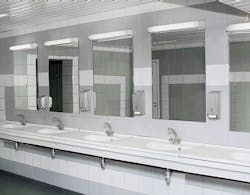Low-flow water fixtures have long been known as an easy water-saving strategy with a relatively quick payback, but despite this, a surprising number of buildings still employ the old high-flows. Is your facility one of them?
If you’re looking to make the financial case for an upgrade, look no further. Discover just how simple – and profitable – a retrofit can be.
Know Your Options
Toilets and faucets are probably the most commonly known low-flow fixtures, but WaterSense also certifies showerheads, urinals, and pre-rinse spray valves. To start your retrofit project with a relatively speedy payback, begin by targeting fixtures that use hot water – namely faucets, showerheads, and pre-rinse spray valves – to derive both water and energy savings. All three are relatively easy to swap.
“Buildings with a high fixture count per square foot, such as barracks, dorms, office buildings, and hotels, generally tend to benefit more, but it depends on what other types of water usage occur in the building,” adds Julia Q. Ortiz, press officer for the EPA, which administers the WaterSense labeling program for water-efficient products.
The Holiday Inn at San Antonio International Airport is just one example of what’s possible. Its bathrooms had not been upgraded since the 236,000-square-foot building’s construction in 1981, so when the local utility, the San Antonio Water System, announced a WaterSaver Hotel program to incentivize retrofits of bathroom fixtures and fittings at local hotels, the Holiday Inn facilities team jumped at the chance.
The result? The hotel saved about 35% on its water bill – a reduction of nearly 7 million gallons – and 330,000 kWh per year after the 2007 retrofit project. This translates to a savings of about $35,000 on annual water and sewer bills, plus another $33,000 per year in energy savings.
Find Financing
Once you’ve identified a good starting point, investigate incentives that could speed up your payback. In Holiday Inn’s case, the local utility provided the new fixtures and installation (roughly $100,000 worth) for all 397 guest rooms as long as Holiday Inn opted for certain specified high-efficiency products. If the hotel had paid for its own upgrades, the resulting savings would have ensured a payback period of just under two years, according to the EPA’s guide WaterSense at Work, which details case studies and best practices for commercial water use.
“Many utilities offer incentives to commercial buildings to improve the water or energy use,” notes Ortiz. “Managers should contact their local utility to see if they offer rebates. The WaterSense website also has a list of utilities with incentives.”
Holiday Inn also instituted other water-saving initiatives, including reusing HVAC condensate for landscape irrigation, planting a rooftop herb garden, and reusing backwash water from the swimming pool and blowdown water from the cooling tower. This is a logical next step to consider after your efficient fixtures have been installed, Ortiz recommends.
“While there are savings to be found in fixtures, cooling water use and outdoor irrigation are the other large water users in commercial buildings,” Ortiz adds. “Facility managers should look for potential savings there as well.”
Janelle Penny [email protected] is senior editor of BUILDINGS.
About the Author
Janelle Penny
Editor-in-Chief at BUILDINGS
Janelle Penny has been with BUILDINGS since 2010. She is a two-time FOLIO: Eddie award winner who aims to deliver practical, actionable content for building owners and facilities professionals.

